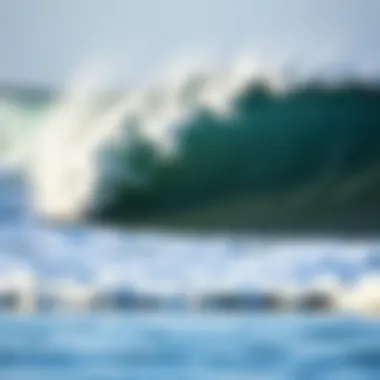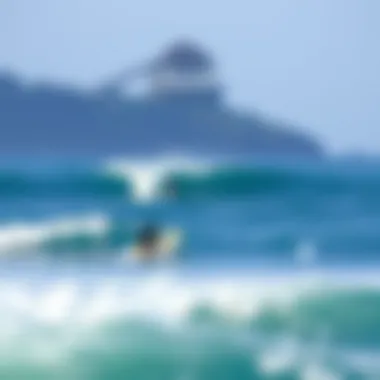Understanding Today's Surfing Conditions for Better Waves


Intro
Surfing is more than just a sport; it's a lifestyle, an art, and for many, a spiritual connection to nature. Today, as the winds shift and waves roll in, understanding current surf conditions is vital for anyone who wants to catch the perfect wave. The interplay between meteorological data, ocean currents, and local environmental factors creates a constantly changing tableau that surfers must navigate. Whether you're a seasoned pro or a weekend warrior, insights into these elements can enhance your experience on the water.
Modern surfers are faced with a plethora of choices regarding gear, techniques, and safety protocols that can greatly influence their time in the ocean. Thus, we will unravel the complexities of current surfing conditions, providing a guide that will allow surfers to make informed decisions, capitalize on favorable conditions, and improve their overall performance.
Navigating these waters takes preparation and awareness. This article not only explores gear and equipment innovations but also delves into effective riding techniques and essential safety practices that every surfer should consider. Armed with this knowledge, you can approach your next surf session with confidence and skill.
Surf Gear and Equipment
When it comes down to hitting the waves, the right gear can make all the difference in the world. Let's look into some of the essentials that every surfer should have.
Latest Surfboard Technologies
Today's surfboards come equipped with a variety of technological advancements that enhance performance on the waves. Boards made with advanced materials such as epoxy or carbon fiber offer a significant reduction in weight while increasing durability and responsiveness. Hybrid designs, combining the elements of shortboards and longboards, allow surfers to enjoy the best of both worlds—the agility of a shortboard paired with the paddle power of a longboard.
The introduction of fins systems like Futures and FCS has revolutionized the way surfers customize their experience. By adjusting fin placement or switching out fins, surfers can fine-tune their boards for different conditions, giving them an edge in performance.
Essential Accessories for Surfers
Aside from surfboards, a range of accessories supports a successful surf session. Consider the following:
- Wetsuits: Depending on the water temperature, a good wetsuit is essential to keep warm and comfortable.
- Leashes: Safety and security on the waves start with a reliable leash. It keeps your board connected and prevents accidents.
- Surf Wax: A small but crucial element, keeping your board grippy is vital for maneuvers.
- Sun Protection: Quality sunscreen and UV-protective clothing safeguard against harmful rays, ensuring you can stay out longer.
Having the proper equipment can dramatically affect your performance and enjoyment in the water.
Techniques and Skills
Once you've geared up, the next step is honing your surf skills to effectively respond to current conditions.
Wave Riding Strategies
Understanding wave patterns is key to maximizing your time on the water. Each wave brings unique challenges and opportunities, so developing strategies tailored to various conditions can determine success. For instance, deploying a bottom turn correctly can set you up for a powerful ride, while drifting the board in a turn allows for fluid transitions and speed.
Many surfers thrive on learning how to read the waves—recognizing the swell direction, understanding how tides affect breaks, and knowing which spots yield the best conditions. With practice, these skills will become second nature.
Safety and Surf Etiquette
Surfing is not just about riding waves; it’s also about respecting fellow surfers and the environment. Safety is a priority—always evaluate the conditions before paddling out. Basic etiquette includes not dropping in on another surfer’s wave and maintaining a respectful distance.
Dangers such as rip currents are something every surfer should be aware of. These currents can lead even experienced surfers into challenging situations, so knowing how to navigate them or what to do if caught is critical.
Collaboration among surfers often leads to the best sessions. Look out for one another and remember that the ocean is shared among all of us.
By carefully considering the right gear, mastering essential techniques, and practicing safe etiquette, you set the stage for a rewarding surf experience that aligns with the current conditions.
Understanding Surfing Conditions
Understanding surfing conditions is pivotal for both enthusiasts and professionals alike. It shapes every aspect of the surfing experience, informing decisions about when and where to hit the waves. This article aims to unravel the complexities behind the elements that dictate wave quality, giving surfers the knowledge to optimize their sessions.
Surfing is not merely a physical activity; it's an art form shaped by nature's many moods. Every surfer wants to know what the ocean has in store, and understanding these elements can significantly enhance your surf outings. Key elements here include wind, swells, and tides—all of which play crucial roles in determining the surfability of a location.
One of the foremost benefits of grasping these conditions is safety. By knowing how wind patterns and tides affect wave behavior, surfers can steer clear of hazardous conditions. This understanding not only protects the individual but also promotes a healthier surfing community. Moreover, understanding surfing conditions allows surfers to maximize their potential on the waves. Choosing the right time and place to surf makes a world of difference. Having the lowdown on intricate weather patterns and ocean dynamics helps surfers to select spots that match their skill level and preferences.
The ocean is like a puzzle, with each piece interacting to create a unique surfing experience. When you peel back the layers, it becomes clear just how interconnected these conditions truly are. For example, a gentle offshore wind can help to smooth out the waves, while an onshore wind can chop them up, making for a less enjoyable experience.
To get a comprehensive grasp of these conditions, consider each element separately, but also keep in mind their combined effects. Monitoring local forecasts, engaging with the surf community, and utilizing surf technology—all of these can contribute to better decisions on the water. In essence, a well-rounded understanding of surfing conditions transforms potential chaos into harmonious rides, enabling surfers to enjoy and respect the ocean's rich tapestry.
"Knowledge is the key to unlocking the secrets of the surf—understanding how wind, swells, and tides work together gives you the power to catch the perfect wave."
A detailed comprehension of surfing conditions is not just beneficial; it's essential for anyone looking to elevate their surfing experience. Next, let’s dive into the crucial role of wind in shaping the surf landscape.
Current Weather Patterns
Understanding current weather patterns is crucial for surfers, as they directly influence surf conditions. Weather factors such as temperature, wind speed, and precipitation can shape the waves you'll encounter, impacting both novice and expert surfers alike. By keeping a close eye on these elements, surfers can significantly enhance their experience on the water. Let’s dive deeper into how these patterns play out and what they mean for your surf sessions.


Analyzing Today’s Conditions
Today’s surfing conditions can vary dramatically just based on the weather alone. For instance, clear skies and gentle breezes might promise serene waves, while overcast skies with strong winds could make for choppy waters.
Here are some key elements to evaluate when analyzing today's conditions:
- Temperature: The air and water temperatures can affect not only your comfort but also the surf conditions. Warmer temperatures often lead to better overall surfs as the water isn't too cold for an extended session.
- Wind Speed: Wind can be a friend or foe. Light offshore winds generally create cleaner waves, while strong onshore winds can ruin perfectly good surf.
- Precipitation: Rain can mean cooler waters, which may deter some surfers. However, it can also lead to cleaner beaches and affect the swell.
Make sure to check local weather stations or apps such as Windy.com to get accurate readings. Tools like the NOAA's coastal forecast can also be great resources for surfers seeking more detailed insights into today’s surf conditions.
Impact of Seasonal Changes
Seasonal changes bring about shifts that can drastically alter surf conditions. Depending on where you’re located, winter may give way to larger swells, while the summer months can see smaller but more consistent waves.
Some effects of these changes include:
- Winter Swells: In many coastal areas, winter is synonymous with powerful swells, thanks to storms further out at sea. This is when you’d want your big-wave board ready.
- Summer Consistency: In contrast, summer often yields smaller, more manageable waves, ideal for beginners or those just looking to enjoy a relaxing day on the water.
- Local Effects: It's worth noting that local geography plays a role too. Areas surrounded by cliffs or certain rock formations can experience unique wave patterns that change with the seasons.
To sum it all up, by paying close attention to current weather patterns, and understanding how seasonal changes impact conditions, surfers can gear up appropriately and make more informed decisions about when to hit the waves.
Local Factors Influencing Surf Quality
Understanding the local elements that shape surf quality is crucial for surfers looking to optimize their time on the water. Factors such as geographical features, the arrangement of reefs, and the presence of sandbars significantly impact wave formation and surf conditions. This section will delve into these elements, highlighting why they matter and how they can affect both novice and experienced surfers.
Geographical Influences
The geography of a surf spot can dictate the quality of waves that a surfer will encounter. Different coastal landscapes provide distinct characteristics that interplay with ocean currents and wind patterns. For instance, a steep coastline can lead to more powerful waves compared to a gradually sloping beach. Here are some geographical influences to consider:
- Topography: The shape of the ocean floor, known as the bathymetry, plays an essential role. A sandy bottom may produce gentle waves, whereas a rocky floor could create sharper, more challenging breaks.
- Coastline Orientation: East-facing beaches typically capture more consistent swells from the ocean compared to west-facing coasts, especially during specific seasons.
- Land Features: Cliffs, islands, and even the presence of piers can alter wave patterns. For instance, a pier can act as a barrier and create a unique wave setup, often good for training and experimentation.
"When it comes to surfing, knowing the lay of the land can be the difference between a fun ride and a wipeout."
These geographical factors influence not just the ride, but also the safety of surfers as conditions can become dangerously unpredictable in certain coastal layouts. Recognizing the nuances of your surf spot's geography isn’t just advantageous; it’s often vital.
Reefs and Sandbars
Reefs and sandbars function like nature's surfboard shaping tool, significantly enhancing the surf experience. They create different types of waves and can transform mediocre conditions into something remarkable.
- Reefs: Coral reefs or rocky reefs are known for producing quality barrels. The steep, abrupt change in depth can create powerful and hollow waves that advanced surfers seek out. However, these can be dangerous for beginners due to potential hazards like sharp coral or sea urchins. Knowing the reef layout is key; for example, reefs like Jeffrey's Bay in South Africa create world-class conditions that many surfers flock to.
- Sandbars: On the other hand, sandbars cause waves that are generally more forgiving. They can break in various directions, offering options for surfers to ride. Conditions can change with the tide, so timing sessions based on the sandbar shape can lead to a more enjoyable surfing experience. Many surfers have their secret spots where sandbars shift, creating perfect waves at the right moments.
Local surfers often share tips and knowledge about specific sandbars and reefs to help each other find the best surf conditions. When visiting an unfamiliar location, engaging in local discussions can unveil hidden gems that maps and apps may overlook.
By understanding how geographical influences, reefs, and sandbars dictate surf quality, surfers can tailor their approach to maximize their sessions. The key is to pay attention to these local factors, as they can provide a significant edge in enjoying the waves.
Safety Considerations
The world of surfing, while exhilarating and freeing, comes with its own set of risks. Understanding the Safety Considerations is paramount for anyone looking to enjoy their time on the waves. Not only does it enhance the overall experience, but it also ensures that surfers are prepared for the unexpected. Taking the time to grasp safety guidelines can mean the difference between a thrilling adventure and a troublesome situation.
Understanding Rip Currents
Rip currents are powerful, channel-like flows of water that move away from shore. They are often misunderstood and can pose a serious threat, especially for those who are new to surfing. The danger lies in their ability to pull even the strongest swimmers into deeper waters, potentially leading to panic and exhaustion.
To recognize a rip current, look for:
- Differences in water color: Often, rip currents appear darker than surrounding water due to the sand being pulled away.
- Foamy surface: A turbulent surface may indicate a current moving out to sea.
- Spotting a gap: Areas where waves do not break can signify the presence of a rip.
If caught in one, don’t fight against the current. Instead, swim parallel to the shore until you're out of its pull, then head back to the beach. Awareness and preparation are key to handling rip currents effectively.
"For every wave that crashes, there lies the tide of safety beneath it. Respect that, and you remain afloat in both spirit and tide."
Identifying Hazardous Conditions
It's crucial to be aware of hazardous conditions that can jeopardize your safety while surfing. Factors such as weather changes, water quality, and local wildlife can dictate whether conditions are safe or dangerous. Some things to keep in mind include:
- Strong winds: These can create choppy waters, affecting both wave stability and visibility.
- Shallow waters: Hitting a sandbar or rock can lead to injuries; it's important to know the area and its depth.
- Increased marine life activity: Certain times of year see heightened interaction with wildlife that could be hazardous, including jellyfish or sharks.
- Pollution: After heavy rains, it's advisable to wait before surfing to avoid exposure to contaminated waters. Local health departments often issue warnings related to water quality following weather events.


Being proactive about these elements enables surfers to gauge the sea’s temperament effectively and adjust their plans accordingly. Never venture into unknown waters without checking both the conditions and your own skill set.
Tools for Surf Forecasting
Proper tools for surf forecasting are essential in making the most out of a surfer's time in the water. They help by providing timely updates about the conditions that surfers encounter, such as wave height, wind speed, and tide schedules. Understanding and harnessing these tools can be the difference between an exhilarating session and a disappointing day at the beach.
Utilizing Surf Reports
Surf reports are crucial for surfers who want to stay ahead of the game. These reports offer real-time data and forecasts, providing insights into current conditions and expected changes. To make the best of these reports, surfers should consider the following:
- Reputable Sources: Always check reliable surf reporting services such as Magicseaweed, Surfline, or local surf shops that often provide community-generated reports. These sources aggregate information from various weather stations and surf buoys for accurate assessments.
- Frequency of Updates: Surf reports can change quickly due to changing weather patterns. Look for services that update their data regularly, ideally every few hours during prime surfing times.
- Regional Focus: Many surf reports are specific to local spots. Familiarize yourself with reports that focus on your favorite beaches, as conditions can vary greatly even within short distances.
- Key Details to Look For: Pay attention to wave height, swell direction, wind conditions, and tide information. Each of these factors plays a critical role in determining surf quality.
"The ocean is a living, breathing entity, and understanding its rhythms can unlock a world of endless possibilities for surfers."
Incorporating Technology in Predictions
With advancements in technology, surfers now have access to tools that were unimaginable a few decades ago. Apps and websites designed for surf forecasting have evolved rapidly, providing not just numbers but sophisticated predictions that can enhance one’s surfing experience. Key technologies to consider include:
- Mobile Applications: Surf forecasting apps like Windy and Surfline allow surfers to check real-time data straight from their smartphones. These apps often feature personalized alerts that notify users when optimal conditions arise.
- Ocean Models and Simulations: Some advanced services utilize oceanographic models that predict swell and wind conditions based on data inputs. This science of ocean modeling enables more long-range forecasts, which can be useful for planning trips to more distant surf spots.
- Community Inputs: Many tech-savvy surfing platforms allow for crowd-sourced reporting, where surfers can share their recent experiences on local conditions. This adds a personal touch to what might otherwise be purely numerical data.
- Wearable Technology: Gadgets like smartwatches can be used to track surfing metrics such as speed and wave count, providing feedback that helps surfers improve their skills drastically.
Integrating these tools into your surfing routine ensures you are not only well-prepared for the conditions but also allows you to continually learn and grow in your surfing journey.
Optimizing Your Surf Experience
Optimizing your surf experience is not just about picking a board and wading into the water. It encompasses a detailed understanding of the conditions, not to mention the personal choices that can substantially affect how enjoyable your time on the waves is. As any seasoned surfer will tell you, riding the perfect wave isn’t merely luck but often hinges upon being well-prepared and attuned to the environment. Whether you’re a weekend warrior or someone who chases swells across the globe, knowing how to optimize your experience can lead to more satisfying surf sessions and fewer duds.
Choosing the Right Board for Conditions
Selecting the appropriate surfboard is pivotal to soaring through waves versus face-planting into them. Each type of board has different characteristics designed to suit particular conditions—understanding this is half the battle. There are a few factors to consider when making this choice:
- Wave Size and Type: Larger waves call for boards with more volume for stability, whereas smaller, quicker waves may require a shorter, more agile board.
- Your Skill Level: Beginners might do better with wider, more stable boards like longboards, while seasoned surfers can handle more responsive designs, such as thrusters.
- Personal Preference: Everyone has their unique style. Some prefer long, cruisy rides, while others might be inclined to aggressive maneuvers.
Choosing a board that matches the surf conditions can make a world of difference. A well-chosen board will align with the waves, resulting in smoother rides and enhanced performance. Don't just stick to one type of board; experiment with different shapes and sizes to see what feels right based on the prevailing conditions.
Timing Your Sessions
Timing your surf sessions can often be the difference between a thrilling ride and a frustrating day in the water. Waves are dynamic; they change with the tides, the wind, and the time of day. Pay attention to these elements:
- Tide Patterns: Many surfers swear by being in the water at high tide or just before it, claiming the waves can be more powerful and better shaped.
- Wind Direction: Offshore winds can create cleaner waves, making it easier to catch and ride. Conversely, onshore winds can create choppy surfaces that might ruin your groove.
- Daily Variations: Surf conditions can shift dramatically throughout the day. Morning sessions often boast fewer crowds, while evening rides might offer stunning sunset backdrops.
To get the most out of your time, consider setting alerts for surf reports or using apps that provide real-time updates on conditions. After all, the early bird catches the best wave.
“An experienced surfer knows that optimizing conditions isn’t about luck; it’s about preparation and awareness.”
In summary, optimizing your surf experience is an ongoing learning curve. Balancing the choice of equipment with timing strategies can greatly enhance your enjoyment and performance. Whether you’re scouting for the best rip or figuring out how to match your skill level with your board choice, each ride is an opportunity for improvement and joy.
Skill Level Considerations
When it comes to surfing, recognizing your skill level is more than just knowing how to paddle out or ride the wave. It's about understanding how various conditions, like tides, wind, and swells, interplay with your ability on the board. This analysis is crucial for both safety and maximizing enjoyment on the water. There's no need to be a seasoned pro to appreciate the complexities involved; even beginners can derive significant benefits from adapting to their surroundings in smart ways. By being mindful of your skill level, you can better read the conditions that day, choose a suitable surf spot, and even select the right equipment.
Adapting to Conditions for Beginners
For those just dipping their toes in the surfing world, adapting to conditions starts with recognizing what you can handle. Beginners must be conscious of their limitations yet should not shy away from exploring various conditions to develop their skills gradually. Here are some points to ponder:
- Choose the Right Spot: Opt for less crowded beaches with smaller waves, allowing you to find your footing without the pressure of competitive surfers around.
- Understand Wave Conditions: Learn to discern between gentle, rolling waves and those that might wipe you out. Soft and steady waves are ideal for practice.
- Gear Up Properly: Consider using a longboard, which provides greater stability, rather than a shortboard until you gain confidence.
- Safety First: Always surf with a buddy and be aware of hazards, such as rocks and currents. Master the art of falling correctly to mitigate injury.
With thoughtful adaptations, beginners can make the most of their time on the water and steadily build confidence. It’s a bit like learning to ride a bike—you gain confidence with each ride.
Advanced Techniques for Experienced Surfers
For those who've spent ample time slicing through waves, the ocean often presents a challenge that calls for enhanced techniques. Experienced surfers can enjoy the thrill of advanced maneuvers, but it’s integral to adapt and push limits effectively:
- Reading the Ocean: The ability to assess waves and their breaking patterns at a glance can set you apart. Refine your skill to understand how swells interact with coastal features.
- Fine-Tuning Equipment: Adjust your board’s fins, experiment with different tail shapes, and find the ideal board length that aligns with current conditions and your style.
- Utilizing Paddle Techniques: Advanced surfers should focus on buoys their paddling strategies, such as late drops or rapid take-offs. Harnessing the right technique can mean the difference between catching a wave and getting left behind.
- Terrain Familiarization: Ride the shifts in your familiar spots. Whether it's dealing with reef breaks or beach breaks, knowing how they behave in various conditions will level up your game.
"In surfing, your ability to read and adapt to changing conditions improves not only your performance but also your safety and enjoyment." - Local Surf Coach


The gap between a novice and an expert is often bridged by a deep understanding of the ocean’s moods. Advanced surfers should always be looking for subtle changes in conditions that can fuel their performances for a more rewarding surf experience.
Through mindful consideration of skill levels and a commitment to adjusting based on their environment, surfers of all types can enrich their time on the waves. Understanding these elements thoroughly not only enhances the thrill of riding but also nurtures respect for the dynamic ocean we play in.
Environmental Factors Affecting Surf
Understanding the environmental factors that influence surfing is critical for anyone who wishes to fully enjoy their time on the water. Not only do these elements determine the overall quality of the waves, but they also play a significant role in ensuring the sustainability of surfing environments. A surfer's ability to navigate these factors can lead to not just a better surfing experience but also a more responsible approach to oceanic ecosystems.
Impacts of Climate Change
Climate change has become a pressing concern for surfers around the globe. The changing climate has significant implications for water temperature, sea level rise, and storm patterns, which in turn affect wave formation. Warmer ocean temperatures can lead to changes in marine life, with species migrating and affecting local ecosystems. Moreover, increased frequency of storm events can cause unpredictable and sometimes dangerous surf conditions.
Surfers must realize the overall instability of conditions brought on by climate change.
"The ocean is like an ever-changing canvas; climate change is the brush that distorts the picture."
For example, areas that previously provided consistent surf may experience drastic fluctuations in wave quality and frequency due to shifting weather patterns. This necessitates a nuanced understanding of weather forecasts and tide charts. Adaptations in gear and technique may also be required, especially as surfers deal with potentially hazardous conditions or changing aquatic environments.
Ocean Conservation Considerations
In addition to changes brought on by climate change, ocean conservation is an essential aspect that surfers must advocate for. The health of marine environments directly correlates to the quality of the surfing experience. Issues such as pollution, overfishing, and coral reef destruction not only damage marine habitats but can also negatively impact wave strength and consistency.
Surfers can play a pivotal role in protecting the oceans by adopting certain practices. Consider joining local clean-up initiatives or supporting organizations that focus on ocean health. Some important conservation practices include:
- Reducing single-use plastics and opting for sustainable materials.
- Participating in educational programs about ocean ecosystems.
- Advocating for policies that protect marine life and surfing environments.
By taking these steps, surfers not only preserve the ocean for future generations but also enhance their own surfing experiences. It’s about cherishing the water we ride on and ensuring that our surf spots remain vibrant and usable for the long haul.
For further insights into climate change impacts and marine conservation, you can explore resources such as NOAA, or Surfrider Foundation, which focus on preserving coastal and oceanic environments.
Local Surfing Communities
The significance of local surfing communities cannot be overstated. These unique groups of enthusiasts not only foster a sense of belonging among surfers but also play a pivotal role in the preservation of surf culture. Engaging with local surfers allows for the exchange of experiences, techniques, and knowledge about regional conditions. Protective measures for the surf environment often arise from these community ties, which boosts the health of local beaches and ultimately contributes to sustainable surfing practices.
Engagement within Surf Culture
Engagement with surf culture often mirrors the connection surfers have with the ocean itself. Local communities act as informal schools where newcomers can learn through observation and participation. For instance, at beaches like Huntington and Waikiki, experienced surfers often take the time to mentor novices, sharing invaluable tips about wave reading and board handling. This interaction is not only essential for skill development but also for cultivating respect for the ocean and the local environment. Through organized events such as surf contests and environmental clean-ups, surfers can deepen their engagement. These gatherings, whether competitive or collaborative, strengthen relationships and elevate local culture, turning surfing into more than just an individual sport.
Sharing Knowledge and Tips Locally
When surfers frequent their local breaks, they naturally accumulate knowledge about the nuances of conditions and the local ecosystem. From tide patterns to the effect of local winds, such insights are fundamental for maximizing surf experience. For instance, a seasoned local at Malibu might informally teach others about how the Northern swells affect the breaks differently during winter.
Besides personal exchanges, platforms like Reddit and local Facebook groups provide spaces for surfers to share their wisdom online, transcending geographical barriers. These platforms serve as repositories for local tips, including optimal surfing spots and safety considerations. Here are some effective ways surfers can share knowledge:
- Organizing Meetups: Casual gatherings can strengthen connections, allowing surfers to learn directly from each other.
- Creating Local Guides: Individuals can develop resources that highlight the unique characteristics of their surf spots, making the information more accessible.
- Utilizing Social Media: Sharing real-time updates about conditions or local happenings enhances community engagement.
Future of Surfing Conditions Forecasting
As we step into the realm of future surfing conditions forecasting, it becomes crystal clear that technology is not just a friend to surfers; it's becoming an essential lifeline. The ability to accurately predict wave conditions can mean the difference between a joyful day on the water and one spent searching for ripples, feeling more like a fish out of water than a surfer. By exploring new technological advancements and sustainability practices in surfboarding, we can embrace a future that enhances our surfing experience while keeping our oceans healthy.
Advancements in Surf Technology
With the evolution of surf technology, we’re witnessing game-changing tools and applications. Gone are the days when surfers relied solely on weather reports or their gut feelings. Now, surfers can utilize smartphone apps that combine real-time data from multiple sources: buoys, satellites, and even wind forecasts. For instance:
- Surfline provides precise hour-by-hour forecasts, which helps surfers choose the best times to hit the waves.
- Magicseaweed is another favorite, known for delivering reliable swell predictions based on user-generated reports from beaches worldwide.
Moreover, wearable devices have come into play. Not only can they track surfing performance, but they can also relay environmental data back to the user. Just picture surfing with a device that tells you how waves are behaving right before you're about to catch them. The prospects sound exciting!
Incorporating machine learning is another stroke of innovation. Companies are leveraging algorithms to analyze vast troves of data for precise forecasting. For example, using historical weather patterns paired with live data, they can predict swell heights and directions with remarkable accuracy. This advancement not only appeals to seasoned surfers seeking optimal conditions but also assists beginners in learning from actionable insights, ultimately shaping the surf community's future.
Sustainability in Surfboarding
As the surf community grows, the necessity for sustainability becomes increasingly pressing. Climate change poses threats to ocean health, directly influencing wave conditions. Surfers have a unique connection to the ocean, which drives them to advocate for better environmental practices.
- Eco-friendly boards are emerging as an answer to the traditional, less sustainable options. Many manufacturers are prioritizing materials that minimize carbon footprints. For instance, Bamboo Surfboards or boards made from recycled materials are gaining traction. They not only hold their own in terms of performance but also give surfers peace of mind knowing they are treading lightly on Mother Nature.
Engaging in ocean conservation projects is another way surfers are making a difference. Initiatives like Surfrider Foundation aim to protect coastlines from pollution and educate surfers about local ecosystems. This involvement can foster a deeper sense of community and an understanding of how personal actions can affect larger environmental conditions impacting surf quality.
"The wave is a reflection of our environmental choices. Protecting our oceans today ensures we can continue to enjoy the sport we love tomorrow."
As we look ahead, blending technology with sustainable practices is essential for the future of surfing. By ensuring that this beautiful sport exists in harmony with the environment, we create a legacy for future generations of surfers. As they ride the waves, they will also feel the pulse of the ocean beneath them, vibrant and alive—just as it should be.















